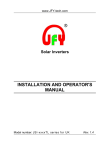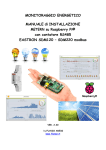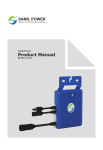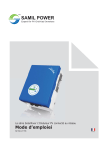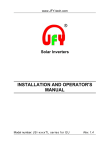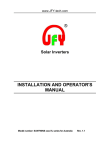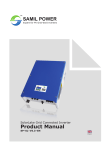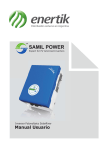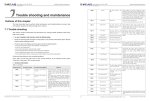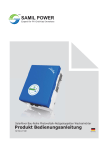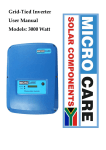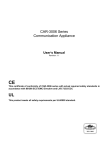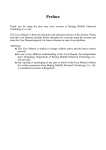Download Samil Power SR 1100 to 5200TL User Manual
Transcript
TM SAMIL POWER Expert for PV Grid-tied Inverters SolarRiver PV Grid-tied Inverter Product Manual SP-SR-V8-EN English Copyright Declaration The copyright of this manual belongs to Samil Power Co., Ltd. Any corporation or individual should not plagiarize, partially copy or fully copy it (including software, etc.), and should not reproduce or distribute it in any form or by any means. All rights reserved. Samil Power reserves the right of final interpretation. This manual is continuously updated based on user feedback. Please check our website www.samilpower.com for the latest version. CONTENTS 1 Notes ................................................................................................................................ 05 1.1 Scope ................................................................................................................................... 05 1.2 Target Group ......................................................................................................................... 05 1.3 Symbols Used ........................................................................................................................ 05 2 Safety ............................................................................................................................... 05 2.1 Appropriate Usage .................................................................................................................. 05 2.2 Important Safety Instructions .................................................................................................. 06 2.3 Explanation of Symbols ............................................................................................................ 06 3 Introduction ...................................................................................................................... 08 3.1 Basic Features ........................................................................................................................ 08 3.2 Electrical block diagram ........................................................................................................... 08 3.3 Dimensions and Weight ........................................................................................................... 10 4 Technical Data ................................................................................................................... 11 4.1 4.2 4.3 4.4 Input (DC) ............................................................................................................................ Output (AC) ........................................................................................................................... Efficiency, Safety and Protection ............................................................................................... General Data ......................................................................................................................... 11 11 11 12 5 Function ............................................................................................................................. 12 6 Installation ........................................................................................................................ 13 6.1 6.2 6.3 6.4 6.5 6.6 Packaging ............................................................................................................................. Installation precaution ............................................................................................................ Preparation ............................................................................................................................ Installation Steps ................................................................................................................... Connections of PV Strings ........................................................................................................ Inverter Start-up .................................................................................................................... 13 14 15 15 17 21 7 Operation ........................................................................................................................... 21 7.1 Control Panel ......................................................................................................................... 21 7.2 Display Function .................................................................................................................... 22 7.3 Display Information ................................................................................................................ 24 8 Communication and Monitoring ......................................................................................... 26 8.1 Communication Interface ......................................................................................................... 26 8.2 Communication types ............................................................................................................. 26 9 Troubleshooting ................................................................................................................ 28 9.1 Troubleshooting ...................................................................................................................... 28 9.2 Routine Maintenance .............................................................................................................. 29 10 Decommissioning ............................................................................................................ 30 10.1 10.2 10.3 10.4 Dismantling OF the Inverter ................................................................................................. Packaging .......................................................................................................................... Storage ............................................................................................................................. Disposal ............................................................................................................................ 30 30 30 30 11 Contact Samil Power ....................................................................................................... 30 03 04 Notes & Safety 1 Notes This manual is an integral part of the inverter, Please read the product manual carefully before installation, operation or maintenance. Keep this product manual for future reference. 1.1 Scope of Validity This manual is an integral part of the inverter. Please read this manual carefully before installation, operation or maintenance and it safe for future reference. SolarRiver 1100TL SolarRiver 1600TL SolarRiver 2300TL SolarRiver 3000TL SolarRiver 3300TL SolarRiver 3680TL SolarRiver 4400TL SolarRiver 5200TL Please keep this manual where it will be accessible at all times. 1.2 Target Group This manual is to be read by qualified installer and PV system user. The tasks described in this manual must only be performed by qualified personnel. 1.3 Symbols Used Some symbols are used in this manual in order to ensure safety of personal and property. Please read the following symbols carefully. Danger! Danger indicates a hazardous situation, if not avoided, will result in death or serious injury. Warning! Warning indicates a hazardous situation, if not avoided, could result in death or serious injury. Caution! Caution indicates a hazardous situation, if not avoided, could result or moderate injury. in minor Note! Note provides tips that are valuable for the optimal operation of your product. 2 2.1 Safety Appropriate Usage The SolarRiver Series is a Solar PV inverter which converts the DC current from a PV generator into AC current and feeds it into the public grid. 05 Safety PV Modules Grid-tied Inverter Grid Figure 1 Solar PV Grid-tied System 2.2 Important Safety Instructions Danger! Danger to life due to high voltages in the inverter! All work on the inverter must be carried out only by qualified personnel. • The appliance is not to be used by children or persons with reduced physical sensory or mental capabilities, or lack of experience and knowledge. • Children should be supervised to ensure that they do not play with this appliance. Caution! Danger of burn injuries due to hot surfaces! During operation, the upper lid of the enclosure and the enclosure body may become hot. • Only touch the lower enclosure lid during operation. Caution! Possible damage to health as a result of effect of radiation! • Do not stay closer than 20 cm to the inverter for long periods. Note! Ground PV generator frame and other electricity conductor surfaces to protect the system and personnel. 2.3 Explanation of Symbols This section gives an explanation of all the symbols shown on the inverter and on the type label. ● Symbols on the Inverter 06 Safety Symbol Explanation 5 min Danger to life due to high voltages in the inverter! There is residual voltage in the inverter. The inverter requires 5 minutes to discharge. • Wait 5 minutes before you open the upper lid or the DC lid. Beware of hot surface. The inverter can become hot during operation. Avoid contact during operation. Danger of high voltages Danger to life due to high voltages in the inverter! Caution, risk of electric shock! Only authorized personnel is allowed to set the DIP switch. ● Symbols on the Type Label Symbol Explanation CE mark. The inverter complies with the requirements of the applicable CE guidelines. ● Important Safety Instructions When using the product, please do follow information below to avoid fire, lightning or other personal injury: Warning! Ensure input DC voltage ≤ the Max.DC voltage. Over voltage may cause permanent damage to the inverter or cause other damages which are not covered in the warranty! This chapter contains important safety and operating instructions. Read and keep this Manual for future reference. Warning! Authorized service personnel must disconnect both AC and DC power from the SolarRiver Series inverter before attempting any maintenance or cleaning or working on any circuits connected to the SolarRiver Series inverter. The installation of inverter must fulfill wiring. ● Before using the SolarRiver Series inverter, read all instructions and cautionary markings on the SolarRiver Series inverter, and all appropriate sections of this guide. ● Use only accesories recommended or sold by Samil Power, otherwise may result in risk of fire, electric shock, or injury to persons. ● To avoid risk of fire and electric shock, make sure that existing wiring is in good condition and cables used are not undersized. Do not operate the SolarRiver Series inverter with damaged or substandard wiring. 07 Safety & Introduction ● Do not disassemble the SolarRiver Series inverter. It contains no user-serviceable parts. See warranty for instructions on obtaining service. Attempting to service the SolarRiver Series inverter the user may result in risk of electric shock or fire and will void the warranty. ● To reduce the risk of electric shock, authorized service personnel must disconnect both AC and DC power from the SolarRiver Series inverter before attempting any maintenance or cleaning or working on any circuits connected to the SolarRiver Series inverter. Turning off controls alone will not reduce this risk. ● Keep away from flammable, explosive materials to avoid fire disaster. ● The installation location should not be close to humid or corrosive substance. ● To avoid electric shock , please do not disassemble the inverter as there are high-voltage capacitances installed inside the inverter. Fatal High-voltage will remain in the inverter for 5 minutes after its disconnection from grid or PV plant. ● To reduce the chance of short-circuits, authorized service personnel must use insulated tools when installing or working with this equipment. 3 3.1 Introduction Basic Features Congratulations on your purchase of a SolarRiver Series inverter from Samil Power. The SolarRiver Series inverter is one of the finest inverter on the market today, incorporating state-of-the-art technology, high reliability, and convenient control features. ● ● ● ● ● ● ● ● ● ● Advanced MCU ( Microcontroller Unit) control technology. Utilize the latest high-efficiency power component. Optimal MPPT technology. Advanced anti-islanding solutions. Excellent protections. IP65 protection level. Efficiency up to 97.6%. Total Harmonic Distortion (THD) <3%. Safe & Reliable: transformerless design with software and hardware protection. Friendly HMI. □ □ □ □ + Step-up DC/DC Converter for MPP Tracking + - L Inverter N AC output terminal Electrical block diagram DC input terminal 3.2 LED status indications. LCD display of technical data, Human-Machine interaction through press key. RS485/RS232 communication interface. PC remote control. PE PV Insulation Detection MCU A MCU B LCD/RS485 RS232 Figure 2 Electrical block diagram 08 RCMU Introduction ● Terminals on the inverter RS232 DC Input AC Output Figure 3 Terminals of PV inverters SolarRiver 1100TL/SolarRiver 1600TL RS485 SF-SW RS232 DC Input AC Output Figure 4 Terminals of PV inverters SolarRiver 2300TL/SolarRiver 3000TL RS485 DC Input SF-SW RS232 AC Output Figure 5 Terminals of PV inverters SolarRiver 3300TL/ SolarRiver 3680TL/ SolarRiver 4400TL/ SolarRiver 5200TL Caution! SF-SW. Risk of electric shock!Only authorized personnel is allowed to set the DIP switch. 09 Introduction 3.3 Dimensions and Weight ● Dimension Figure 6 SolarRiver 1100TL/SolarRiver 1600TL 328mm 443mm Figure 7 SolarRiver 2300TL/SolarRiver 3000TL 347mm Figure 8 SolarRiver 3300TL/SolarRiver 3680TL/SolarRiver 4400TL/SolarRiver 5200TL ● Weight Table 1 Weight in kilo grams, kg 10 Model SolarRiver 1100TL SolarRiver 1600TL SolarRiver 2300TL SolarRiver 3000TL SolarRiver 3300TL SolarRiver 3680TL SolarRiver 4400TL SolarRiver 5200TL Weight [kg] 11.4 11.4 17.5 17.9 18.9 19.2 19.2 19.4 Technical Data 4 Technical Data 4.1 Input (DC) Model Max.DC power [W] SolarRiver SolarRiver SolarRiver SolarRiver SolarRiver SolarRiver SolarRiver SolarRiver 1100TL 1600TL 2300TL 3000TL 3300TL 3680TL 4400TL 5200TL 1100 Max.DC voltage [V] Max. input current [A] 1600 2300 3480 500 8.8 4000 4580 5200 20 21 26 550 9.7 Number of MPP trackers/ Strings per MPP trackers 11 13.5 17.5 1/1 MPPT voltage range (at rated powe) [V] 120-425 160-425 Shutdown voltage/ Start voltage 75/100 4.2 3000 1/2 200-500 210-500 200-500 70/100 Output (AC) Model SolarRiver SolarRiver SolarRiver SolarRiver SolarRiver SolarRiver SolarRiver SolarRiver 1100TL 1600TL 2300TL 3000TL 3300TL 3680TL 4400TL 5200TL AC rated power [W] 1000 1500 2000 2600 3000 3680 4000 4600 MAX. AC power [W] 1000 1500 2200 2800 3300 3680 4400 5000 Rated AC current [A] 5.5 8.3 11 13.8 16 16 22 24 Nominal AC voltage/ range [V] 230 / 180~270* AC grid frequency/ range [Hz] 50 / 47~52* Power factor (cosφ) 1 Total harmonic distortion (THDi) (at nominal power) <3% *Detailed parameter please see local grid standard. 4.3 Efficiency, Safety & Protection Model SolarRiver SolarRiver SolarRiver SolarRiver SolarRiver SolarRiver SolarRiver SolarRiver 1100TL 1600TL 2300TL 3000TL 3300TL 3680TL 4400TL 5200TL Max. efficiency 96.6% 96.8% 96.8% 97.0% 97.4% 97.6% 97.6% 97.6% Euro- efficiency 95.5% 96.0% 96.2% 96.3% 96.5% 97.1% 97.1% 96.8% MPPT efficiency 99.9% Safety & Protection Overvoltage / undervoltage protection DC isolation impedance monitoring Yes Yes 11 Technical Data & Function Continued: Ground fault protection Yes Grid monitoring Yes Ground fault current monitoring Yes DC injection monitoring Yes 4.4 General Data SolarRiver SolarRiver SolarRiver SolarRiver SolarRiver SolarRiver SolarRiver SolarRiver 1100TL 1600TL 2300TL 3000TL 3300TL 3680TL 4400TL 5200TL Model Dimensions (W/H/D) [mm] 285 / 385 / 145 328 / 450 / 161 Weight [kg] 11.4 17.5 11.4 347 / 443 / 180 17.9 18.9 Convection Cooling concept <28 Noise (typical) [dB] <28 <30 <30 <30 IP65 Internal consumption (night) [W] 0 Operating temperature range [℃] 19.2 19.4 Fan Degree of protection <40 <40 <40 -20 °C ~ +60 (derating at 45 °C) Transformerless Topology Backlight, 16*2 character LCD LCD display Communication interfaces RS232 Standard warranty [year] 5 19.2 RS232 RS485 / RS232 5 years Function Operation Mode 【Stand-by Mode】 The standby mode means that the inverter is ready for operation but still not connected to the grid. In this mode, it will continue to check whether PV array has enough power to feedback into grid. When the inverter passes dump load test after startup, it will change from standby mode to Checking mode. 【Checking Mode】 If inverter passes dump load test and no error/fault occurs, will start checking mode to deliver power. 【On-grid Mode】 In this mode, SolarRiver series inverters convert PV array’s DC into AC and feedback into grid. Caution! It is normal that the inverter decreases the output power in the condition of thermal protection, but if this occurs frequently the heat sink and the fan will need to be checked and the inverter may need to be shifted to a place with 3 SolarLake Anschlussklemmen betterBild air flow. If the fan is dirty it shoulddes be Wechselrichters cleaned and if the output power decrease is caused by electricity issues, please ask for professional support. 12 Installation 【MPPT Mode】 The default setting is MPPT mode, the operation mode will return to MPPT after DC&AC restart. 【Fault Mode】 If any fault/error occurs, inverter will stop delivering power until the fault/error is rectified. Some fault/ error will recover automatically, and others may need manual restart. 【Setting Mode】 Press “Function” key for 5 seconds to get into the Setting mode if DC power exists. Please refer to chapter 7 of the Manual more information. 6 6.1 Installation Packaging 6 Eng lish Type Project No. Description QTY Equipment 1 PV Grid-tied Inverter 1 unit Accessories 2 Backboard 1 pc 3 Installation Kit 1set Accessories 4 AC connector(SolarRiver 1100TL-1600TL) 1 pc 5 DC connector assembly 1/2 6 Files 7 AC connector(SolarRiver 2300TL-5200TL) Packing list 1 pc 1 pc 8 Quality certificate 1 pc 9 Product manual 1 pc 10 Warranty card Remark Installation Kit for SolarRiver 1100TL-1600TL include: M4 screw, expansion screw, M5 screw rivet. Installation Kit for SolarRiver 2300TL-5200TL include: M5 flange nut, expansion screw, M5 screw rivet. 1 pc 13 Installation 104.5mm 104.5mm 25.5mm 85mm 126.6mm 85mm 25.5mm SolarRiver 1100TL~1600TL Inverter Backboard 160mm 160mm 120mm 60mm 130mm 192mm 167.5mm 60mm SolarRiver 2300TL~5200TL Inverter Backboard Warning! Ensure that the DC side is not charged before installation or maintenance. If the inverter is powered the capacitors will be charged if after the inverter is turned off, hence it is to wait for 5 minutes to ensure that the capacitors are discharged. Note! Inverters must be installed by qualified personnel only . 6.2 Pre installation precautions Check the location where inverter is to be installed to ensure the following. ● ● ● ● ● ● ● ● 14 The ambient temperature is within the operation range ( -20°C to +60°C -4°F to +140°F ). The altitude is less than 2,000 m. Not prone to be damaged by sea water. Not close to corrosive gas or liquid (for example, locations where chemicals are processed or lots of poultry is fed). Not exposed to direct sunlight. Not prone to be flooded snowed in. Ensure good ventilation and low humidity. Not exposed to steam, vapor, or water. Installation ● ● Not exposed to direct cool air. Not close to television antenna or antenna cable. Inverter needs at least 30cm (see table 2) clearance. If this is not observed, inverter is likely to malfunction high temperature inside the inverter. Samil Power will not cover any damage due to this condition. Position Min. clearance Side 30cm Top 30cm Bottom 30cm Front 10cm Table 2 Minimum clearance needed 6.3 Preparation Following tools are needed for installation. Installation Tools Installation Tools: Crimping tool, Plier, Screwdrivers and adjustable spanner and Drill machine. 6.4 Installation Steps ● SolarRiver 2300TL~5200TL Models Step1: Drill holes in the wall with drill machine according to the size of bracket. Drill straight into the wall do not shake the drill to avoid damage to the wall. Depth of the holes should be about 30mm and should be the same in all the holes. After removing dust from the holes, measure the net depth of the holes. If the depth is more than 33mm or less than 27mm, the expansion pipes can not be properly installed. 1 2 Expansion Screw Expansion Pipe Figure 9 Installation of Expansion Pipe 15 Installation Step2: Clean all dust outside/inside the hole and ensure the distances between hole are as per requirement. Insert expansion pipes into the holes vertically, use rubber hammer to tap the pipes into the wall completely. Insert the bracket into expansion pipes and use expansion screws to fasten the bracket. Figure 10 Bracket Installation Step3: Mount inverter onto the narrow vertical panel, ensure upper corner of the inverter is hooked onto the bracket, use M5 screws to fix the lower part of the inverter to the bracket (See figure 10). Step 4: Use M5 flange nut to fix the bottom of the inverter. Step 5: Complete the installation process. ● SolarRiver 1100TL~1600TL Models Step1: Drill holes in the wall with drill machine according to the size of bracket. Drill straight into the wall do not shake the drill to avoid damage to the wall. Depth of the holes should be about 30mm and should be the same in all the holes. After removing dust from the holes, measure the net depth of the holes. If the depth is more than 33mm or less than 27mm, the expansion pipes can not be properly installed. Step2: Clean all dust outside/inside the hole and ensure the distances between hole are as per requirement. Insert expansion pipes into the holes vertically, use rubber hammer to tap the pipes into the wall completely. Insert the bracket into expansion pipes and use expansion screws to fasten the bracket. Step2 Step4 16 Step3 Step5 Installation Step3: Use the bracket to install the inverter onto the narrow vertical panel (or wall). Ensure the upper corner of inverter is attached onto the bracket. Step4: Make sure the bracket and the inverter’s right side screw hole are in line and matching well, fix the screw into the hole and screw into the inverter tightly. Step5: If necessary lock the inverter and the bracket with padlock (not included) for safety. 6.5 Connections of the PV power system ● PV String SolarRiver inverters 3300TL, 4400TL and 5200TL have facility to connect two strings of PV moduleswhile the other models can only take one module string. Use only PV modules with excellent performance and reliable quality. Open-circuit voltage of modules connected in series should be <Max. DC input voltage of the inverters (Ref Table 3) and the operating voltage at all times should be within the MPPT voltage range. Table 3 Max. DC Voltage of inverters Model Max. DC voltage SolarRiver SolarRiver SolarRiver SolarRiver SolarRiver SolarRiver SolarRiver SolarRiver 1100TL 1600TL 2300TL 3000TL 3300TL 3680TL 4400TL 5200TL 500V 550V Only use good quality PV cables to connect modules to inverter. Normally the voltage drop between modules and inverter could be about 1-2%. Hence inverter should be installed as close to the PV module as possible to reduce cable losses. Note! Please don’t connect the PV panel positive or negative to ground. Figure 11 Use of Multimeter to measure module array voltage Warning! PV modules carry high DC voltage which is dangerous, please comply with all electrical safety rules and regulations when working. Warning! In case of any faults with module arrays, do not connect the inverter to the arrays. 17 Installation Note! Need not connect the input terminal to optimizer. ● AC Output SolarRiver series inverters are designed for single phase grid. Operating AC voltage range from 180V to 260V (200V-270V for Australia) and the typical frequency is 50Hz. Other operating parameters should comply with local public grid regulations. Table 4 Cable and MCB Requirement Model SolarRiver 1100TL Cable (Cu) 1.5mm² MCB 10A SolarRiver SolarRiver SolarRiver SolarRiver SolarRiver SolarRiver SolarRiver 1600TL 2300TL 3000TL 3300TL 3680TL 4400TL 5200TL 2.5mm² 4mm² 16A 20A 4mm² 4mm² 4mm² 4mm² 4mm² 20A 25A 25A 25A 32A MCB with rated fault current of 30 mA≤Ifn≤300 mA should be installed between inverter and grid. No load should be connected directly with the inverter. Figure 12 Incorrect connections between Load and Inverter Impedance of the AC connection should be less than 2Ω. To ensure anti-islanding function PV cable should ensure power loss to be <1% of nominal power. Also AC cable between inverter and connection point should be less than 150m. Chart below provides relationship between AC cable length and cross section with losses. 1.4% 2.5mm2 4.0mm2 6.0mm2 1.2% 8.0mm2 10.0mm2 1.0% Loss 0.8% 0.6% 0.4% 0.2% 0.0% 0m 10m 20m 30m 40m 50m 60m 70m 80m 90m 100m Length Figure 13 AC Cable Loss for SolarRiver 3300TL SolarRiver inverters come with good quality IP66 AC connector. Please refer to information below to make correct AC connection. 18 Installation Pressure screw Thread sleeve with sealing ring 10-14mm Socket element sealing ring 6-10mm SolarRiver 2300TL~5200TL SolarRiver 1100TL~1600TL Figure 14 AC Connector details Follow following steps for wiring AC Connectors. Step1: Pass the AC wire through the threaded sleeve and pressure screw (See figure 15). Pressure screw Thread sleeve Figure 15 Step2 : Connect the AC cables as explained below. • Fix the green and yellow ground cable to the ground terminator in the AC Connector (Figure 16). • Fix the blue Neutral cable to the N(Neutral) terminator in the AC Connector. • Fix the Line cable (brown or black wire) to the L(Line) terminator in the AC Connector. Figure 16 AC Connector 19 Installation Step3: Confirm that all the wires are fixed tightly( Figure 17). Pressure screw Connected wires Thread sleeve Socket element Figure 17 Step4: Fix the threaded sleeve (Figure 18). Pressure screw Socket element Thread sleeve Figure 18 Step5: Fix the pressure screw (Figure 19). Pressure screw Threaded sleeve Figure 19 Step6: Connect AC connector to inverter (Figure 20). Figure 20 20 Installation & Operation 6.6 Inverter Start-up • Only start inverter after checking following a. Make sure all the DC and AC breakers and Isolators are in off position. b. AC cable from inverter to connection point is done correct. c. All PV panels are connected to inverter correctly,Unused DC connectors should be sealed using covers provided. • Starting inverter a. Turn ON AC MCB. b. Turn ON DC Isolator and then AC Isolator. c. Inverter will start up automatically when PV arrays generates enough energy. Inverter goes through the following three stages during normal start-up. Waiting: Inverter is waiting / checking PV arrays output DC voltage to be with adequate . Checking: Inverter checks AC grid conditions automatically when DC input voltage exceeds Start-up voltage. Inverter then goes through the start-up count down. Normal: Inverter begins to operate normally with green light ON and feed energy to grid, LCD displays present output power. Inverter will stop feeding power to grid when PVoutput is not enough for normal operation. Note! If inverter shows “Fault” status, please refer to Part 9. 7 7.1 Operation Control Panel Figure 21 Control Panel Normal (green):The inverter is working in normal state. Fault (red):The system is in fault state. Function key:To check the operating parameters, for details, see section 7.2. 21 Operation 7.2 Display Function The function key is used to set the LCD. It can alternate between different parameters and languages. Use Function Key to check and set inverter parameters SolarRiver 4400TL Pac=x.xW Display on normal operation Inverter will change into standby mode when 100V<the dc input <150V. When the PV voltage>150V, Inverter will change into “Normal State” mode after 180 second start-up time. Waiting Pac=x.xW Checking 180s Pac=x.xW Normal State Pac=x.xW 22 Operation Initial State LCD lights up. Normal State Pac=xxxx.xW Displays total Energy. Etotal=xx.xkwh Pac=xxxx.xW Displays n day’s energy. Etoday=.xxxx.xkwh Pac=xxxx.xW Displays the PV voltage. Vpv=xx.xV Pac=xxxx.xW Displays inverter model. SolarRiver 4.4kW Pac=xxxx.xW Displays software version. Ver. V1.00 Pac=xxxx.xW Language setting. Select Language Pac=xxxx.xW Energy today reset. Reset Etoday Pac=xxxx.xW Displays PV current. Ipv=xx.xA Pac=xxxx.xW Displays AC voltage. Displays the initial state. Normal State Pac=xxxx.xW Vac=xx.xV Pac=xxxx.xW Displays AC current. Iac=xx.xA Pac=xxxx.xW Displays AC frequency. Freq.=xxxHz Pac=xxxx.xW 23 Operation (Press Function key to check data will go back to initial state after 10s of inactivity) Lockup function as below: Set language as below: Udc=xx.xV Normal State Pac=xxxx.xW Pac=xxxx.xW Press the Function key for 5 Press the Function key 10 times, seconds, it will be locked. it will display the language setting. Lock Select language Pac=xxxx.x Pac=xxxx.xW Press and hold the Function Key to change language English Udc=xx.xV Pac=xxxx.xW Pac=xxxx.xW Press the Function key, it will After a brief period of inactivity, the go to next state. display returns to “Normal State” Idc=xx.xA Normal State Pac=xxxx.xW 7.3 Pac=xxxx.xW Display information Table 5 Display Information Operating State Description Information Display Working Condition Power Off No display DC input voltage<70V,inverter stops working Initialization& Waiting Waiting 70V< DC Input voltage≤150V in standby mode Checking Checking Input voltage >150V in grid checking mode Normal State Normal state Inverter is working in grid-tied mode Flash Flash Upgrading software Checking Parameters 24 Real-time Power Pac=xxxxW Real-time output power Total energy generation Etotal=xxxxkWh Total energy generated Operation Continued: Output Voltage Vac=xxx.xV Output voltage Output Frequency Freq.=xx.xHz Output frequency Output Current Iac=xx.xA Output Current PV Input Voltage Vpv= xxxV PV input voltage PV Input Current Idc= xxx A PV input current Fault Information Isolation Fault Isolation Fault Grounding fault or surge voltage protection failure Leakage Detecting Ground I Fault Leakage current over rating Fault OVR AC Over voltage rating Fault UVR AC Under voltage rating Fault OFR AC Over frequency rating Fault UFR AC Under frequency rating No Utility No Utility No Utility Fan Fault Fan Fault Fan locked or circuit fault PV Over Voltage PV Over Voltage PV voltage ≥ Max.DC voltage Consistent Fault Consistent Fault CPU or other hardware failure Relay Failur Relay Failure Relay between grid and inverters failed DC INJ High DC INJ High DC injection in AC output over rated value. EEPROM Failure EEPROM Failure EEPROM’s failure SCI Failure SCI Failure MCU internal communication failure High DC Bus High DC Bus DC bus voltage is higher than the set value DC Sensor Fault DC Sensor Fault Input DC detector failure GFCI Failure GFCI Failure Leakage current detecting circuit failure Grid Fault Others Lock Lock Frozen information Reconnect Reconnect Reconnect to grid after relay disconnect Inverter’s Version Ver xx.xx Version information 25 Communication and Monitoring 8 8.1 Communication and Monitoring Communication Interface SolarRiver inverters have communication interface RS485 and /or RS232 depending on model. Output voltage, current, frequency, fault information, etc., can be delivered to a PC or other monitoring equipment via the RS485/RS232. 8.2 Communication types SolarRiver inverters come with one or both of the following types communication facility depending on model. ① RS232 Communication RS232 is a standard communication interface within 12m. It transmits data between PC and one SolarRiver series inverter (Figure 22). Figure 22 RS232 Communication Diagram Figure 23 RS232 Communication Cable and Interface Table 6 RS232 Pin Definition Pin 1 2 3 4 5 6 7 8 9 Function NC TxD RxD NC Common (GND) NC NC NC NC Only one inverter can be connected with a PC at one timethrough RS232 port. This facility is generally used for single inverter communication, software update and testing by service person. ② RS485 Communication ● Communication RS485 allows upto 32 inverters to communicate at the same time. But the total cable length should not be more than 1200m. SolarLog can be used for monitoring multiple inverters at the same time. Users can browser the PV plants operating data collected by SolarLog through PC. Connecting the system as blow (figure 24), user can easily monitoring the PV power station. 26 Communication and Monitoring server Router Figure 24 SolarLog Monitoring Diagram Two types of cable must be prepared when using SolarLog for monitoring multipleinverters. Inverter wiring Find a Ethernet cable with appropriate length. At one end of the cable, strip off about 2 inches of the Ethernet cable sheath. Choose 4 wires (brown,brown white, orange , orange white), and press the 4 wires into pin1 to pin4 of the RJ11 crystal head as below. Then Insert the ready-made crystal head into RS-485 port of inverter. Figure 25 Inverter wiring SolarLog Wiring On the other end of the cable, strip off about 2 inches of the Ethernet cable sheath. Choose 4 wires (brown, brown white, orange , orange white), press them into the foot 4,1,6,5 of SolarLog. The foot number is 1 to 6 from left to right as below. Figure 26 SolarLog Wiring 27 Troubleshooting 9 9.1 Troubleshooting Troubleshooting This section contains information and procedures for solving possible problems on SolarRiver series inverters, and provides troubleshooting tips to identify and solve most problems. This section will help narrow down the source of any problems which you may encounter. Please read the following troubleshooting steps. ● Check the warning or fault messages on the System Control Panel or Fault codes on the inverter information panel. If a message is displayed, record it before doing anything further. ● Attempt the solution indicated in Table 7. ● If the inverter information panel is not displaying a Fault light during a fault condition, check the following to make sure that the installation allows proper operation of the unit. — Is the inverter located in a clean, dry, adequately ventilated place? — Is the DC Isolator in ON position? — Are the cables adequately sized and short enough? — Are the input and output connections and wiring in good condition? — Are the configurations settings correct for the particular installation? — Are the display panel and the communications cable properly connected and undamaged? Contact installer or Samil Power Customer Service for further assistance. Please be prepared to describe details of the system installation and also provide the model and serial number of the inverter. Table 7 Troubleshooting tips Faults Grid Fault - Wait for some time to allow grid supply to stabilize for inverter to go back to normal working state. - Making sure that grid voltage and frequency complies with standards. - Seek help from installer. No Utility - PV Over Voltage DC INJ High SCI Failure Isolation Fault Consistent Fault 28 Diagnosis and Solutions No grid supply. Check grid connection like cables , interface, etc. Check grid usability. Seek help from installer. - Check the panel’s open-circuit voltage to be less than Max.DC voltage. - If PV open circuit voltage is higher consider rewiring modules to get voltage under limits. - Wait for a minute to see if DC injection returns to normal.. - If fault persists, contact Samil Power for assistance. - Disconnect PV +ve and –ve input, and re-connect after a short break. - If fault persists, contact Samil Power for assistance. - Check the impedance between PV (+)、PV (-) and ground. For SolarRiver 2300TL~SolarRiver 5200TL >1Mohm . - Contact Samil Power if impedance value is not big enough. - Disconnect PV +ve and –ve input, and re-connect after a short break. - If fault persists, contact Samil Power for assistance. Troubleshooting Continued: Fan Fault 9.2 - Check the fan for any block. - Check fan cables. - If fault persists, contact Samil Power for assistance. Relay Failure - Disconnect PV +ve and –ve input, and re-connect after a short break. - If fault persists, contact Samil Power for assistance. Ground I Fault - Leakage current is too high. - Disconnect DC and AC connector, check equipment on the AC side for concerns and rectify any faults found. - Reconnect the DC input and check operation.. - If fault persists, contact Samil Power for assistance. EEPROM Failure - Disconnect PV +ve and –ve input, and re-connect after a short break. - If fault persists, contact Samil Power for assistance. High DC Bus - Disconnect PV +ve and –ve input, and re-connect after a short break. - Check AC connection for faults. - If fault persists, contact Samil Power for assistance. GFCI Failure - Disconnect PV +ve and –ve input, and re-connect after a short break. - If fault persists, contact Samil Power for assistance. Routine Maintenance Inverters generally do not have any maintenance needs. The cooling fan is fitted should not be blocked or covered in dust. ● Cleaning of inverter Use small electric blower, soft dry cloth or brush to clean inverters. Water, corrosive chemical, or intense cleaning agents should not be used. ● Cooling fin cleaning To ensure proper inverter performance adequate space needs to be left all around the inverter and heat emitter at the back. Fan should not be blocked by dust, snow or any other object. Use air blower, soft cloth or brush to clean cooling fin. Water, corrosive chemicals or intense cleaning agents should not be used for cleaning inverter or fan. 29 Decommissioning & Contacting Samil Power 10 Decommissioning 10.1 Dismantling the Inverter ● Disconnect the inverter from DC Input and AC output. ● Remove all connection cables from the inverter. ● Remove the inverter from the bracket. 10.2 Packaging If possible, pack the inverter in the original packaging. If original packaging is not available, use an equivalent carton that meets the following requirements. ● Suitable for loads more than 25 kg. ● With handle. ● Can be fully closed. 10.3 Storage Store the inverter in dry place where ambient temperature is always between -20 °C ~ +60 °C. 10.4 Disposal Return faulty inverters to Samil Power for repair or recyle. 11 Contacting Samil Power If you have any questions about SolarRiver series inverter, please call service support hotline: +86 510 83593131. Please have the following information ready when contacting Samil Power. a. Inverter Model. b. Inverter Serial No.. c. Communication Method. d. PV modules make, model and units. 30 SAMIL POWER CO., LTD. Marketing & Sales Office Factory Add: Add: No.52,Huigu Innovation Park, Huishan District, Wuxi,Jiangsu Province,P.R.China 214174 Tel: +86 510 83593131 Fax: +86 510 81819678 E-mail:[email protected] http://www.samilpower.com Tel: Fax: No.66 Taihangshan Road, Suyu Economic Development Zone, Suqian City, Jiangsu Province, P.R.China 223800 +86 527 88754666 +86 527 84453877








































